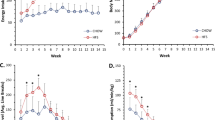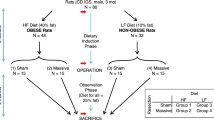Abstract
*Objective:*
To model nutritional obesity in rats with two-bottle-feeding method according to human eating feature. *Design:* Animals were grouped into control and model randomly according to their initial body weight. The control rats fed with standard chow singly and the model rats fed with the standard chow and a high fat (HF) diet simultaneously for 20 weeks. Lee’s index of control was used as the reference of obesity identification. The inducing effect of this method and animals’ eating features were studied. *Subjects:* 142 weaned male Sprague-Dawley (SD) rats (body weight: 43.95±4.0g). *Measurements:* Body weight (BW), body length (BL), and food accumulation were measured weekly, and Lee’s index was calculated for obesity evaluation.
*Results:*
This modeling process based on human eating feature facilitated the production and evaluation to HF diet, and showed an effective inducing effect. At the end of 14th week, about 51% rats (by Lee’s index) or 70.6% rats (by body weight) developed obesity and all developed fatty liver. Animals’ preference to HF diet was proved to be varied greatly. Its influence on obesity and obesity resistance (OR) rats can be balanced by two-bottle-feeding method, p=0.42. Obesity rats ate more HF diet than OR rats, but they ate same amount of chow. On the other hand, Lee’s index of the animals was not well related to energy intake, r2=0.48. Thus, animal’s preference to HF diet and their own metabolic feature were potential influence factors, except for these factors, animals’ food intake and energy efficiency are key factors deciding obesity.
*Conclusions:*
Two-bottle-feeding method is an effective way to modeling nutritional obesity as well as fatty liver in rats. Food-intake and energy efficiency are inner key factors deciding obesity or obesity resistance.
Similar content being viewed by others
Article PDF
Author information
Authors and Affiliations
Corresponding author
Rights and permissions
About this article
Cite this article
Zhang, J., Sun, X., Gao, P. et al. Energy or chow, that’s a question: “two-bottle” may be more suitable than “one-bottle” in modeling nutritional obesity. Nat Prec (2008). https://doi.org/10.1038/npre.2008.2572.1
Received:
Accepted:
Published:
DOI: https://doi.org/10.1038/npre.2008.2572.1



